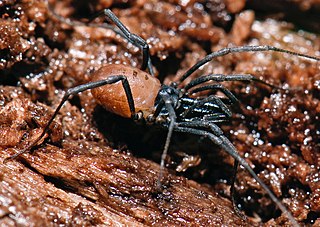
Dyspnoi is a suborder of harvestmen, currently comprising 43 extant genera and 356 extant species, although more species are expected to be described in the future. The eight families are currently grouped into three superfamilies: the Acropsopilionoidea, Ischyropsalidioidea, and Troguloidea.

Sabacon is a genus of the monotypic harvestman family Sabaconidae, with 59 species.

Ischyropsalididae is a family of harvestmen with 35 described species in 3 genera, found in Europe and North America.

Taracus is a genus of harvestman, or Opiliones, typically found living in limestone and lava caves in the United States. They grow to a size of 2.0–5.5 mm (0.08–0.22 in).
Crosbycus is a potentially monotypic genus of harvestmen in the family Taracidae, with one species found in North America as of 2023, per the World Catalog of Opiliones.

Acuclavella is a genus of thorn harvestmen in the family Ischyropsalididae, found in the Pacific Northwest. There are about seven described species in Acuclavella.

Taracidae is a family of harvestmen in the order Opiliones. There are 4 genera and 23 described species in Taracidae.
Cladolasma, is a genus of harvestmen belonging to the family Nemastomatidae. The genus is monotypic containing a single species Cladolasma parvulum. They are endemic to Japan, with records in Ehime and Tokushima Prefectures. The genus was described by Seisho Suzuki, with the type species Cladolasma parvulum Suzuki, 1963, subsequently revised to Dendrolasma parvulum in Suzuki (1974), but later restored as a valid genus.

Ortholasma is a genus of harvestmen in the family Nemastomatidae with 5 described species. The genus has been revised by Shear (2010).

Hesperonemastoma is a genus of harvestmen in the family Taracidae. There are about five described species in Hesperonemastoma.
Ceratolasma is a genus of harvestmen in the family Ischyropsalididae, found in the Pacific Northwest. There is one described species in Ceratolasma, C. tricantha.

Dendrolasma is a genus of harvestmen in the family Nemastomatidae with two described species. Both species are found in the western coast of North America. An overview of their taxonomy was provided by Schönhofer (2013).

Ortholasmatinae is a subfamily of harvestmen in the family Nemastomatidae with 27 described species in 7 genera. They are found in temperate and often mountainous regions of the Northern Hemisphere.

Taracus marchingtoni is a genus of harvestman found in the lava caves of semi-arid and arid regions of central Oregon. It belongs to the family Taracidae and was first collected by Jean and Wilton Ivie in 1965 in Lava River Cave but not identified as a new species until collected by Neil Marchington of the Oregon High Desert Grotto in 2008. Its range is suspected to be the surrounding areas of Newberry Volcano. It has enlarged but thin chelicerae, typically equal to or longer than the entire length of the body, and in small-bodied males nearly three times as long. The harvestman is troglobiotic and has a predominantly white abdomen, black chelicerae, and highly reduced eye size. T. marchingtoni has been observed feeding on small troglophilic millipedes identified as Plumatyla humerosa of the Conotylidae family.

Plumatyla humerosa is a millipede species found in mines, as well as lava tube and limestone caves of northern California and south-central Oregon. It belongs to the family Conotylidae. The millipede is likely a troglophile with a white carapace and observed in lava caves though it may inhabit crevices as well. P. humerosa is observed frequenting areas with mold or bat feces on the cave floors. Taracus marchingtoni has been observed feeding on P. humerosa within cave habitat.
Acropsopilionoidea is a superfamily of harvestmen with 1 family and 3 genera, found in North America and the Southern Hemisphere.
Asiolasma is a genus of harvestmen in the family Nemastomatidae with six described species . The species are found in Southeast Asia, namely China, Vietnam and Thailand. Some species are treated under other genera in Schönhofer (2013).
Martensolasma is a genus of harvestmen in the family Nemastomatidae with two described species . Both species are found in Mexico. The type species was include in catalog by Schönhofer (2013). The genus Martensolasma was described by William Shear, with the type species Martensolasma jocheni Shear, 2006. A second species was later added to the genus by Cruz-López, 2017.
Troguloidea is a superfamily of harvestmen with 4 genera, found mostly in Europe, Asia, and North America.








